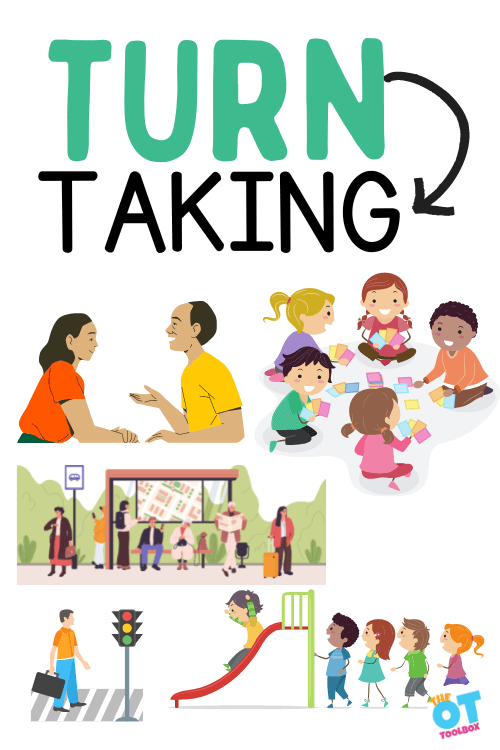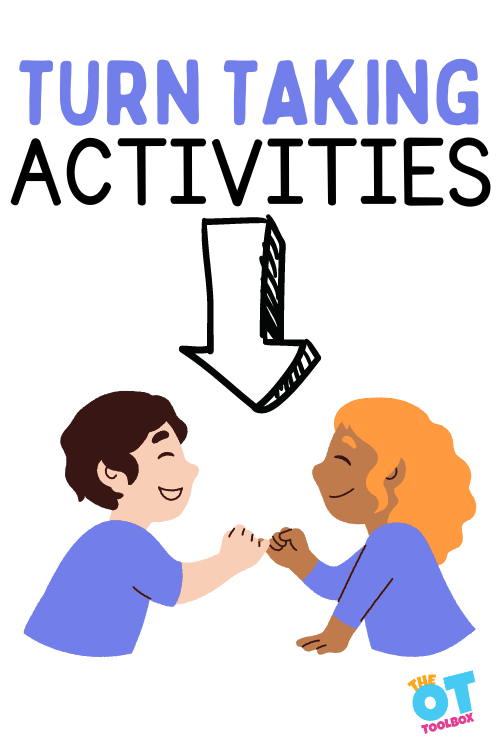Having a mindful Thanksgiving is so important, but have you ever considered HOW to achieve Thanksgiving mindfulness during a time when abundance is everywhere? Today, we have a few tips on holiday mindfulness, but also a great turkey exercise. This Thanksgiving deep breathing exercise is a tool to use when the overwhelming feelings of a big holiday event can overcome emotions and behaviors. Add this turkey activity to your Thanksgiving occupational therapy plans.
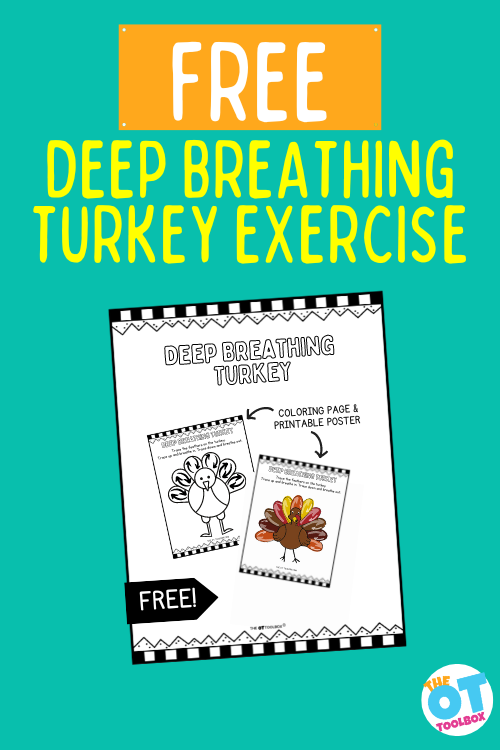
Thanksgiving Mindfulness
This time of year, being mindful is a huge part of the gratitude of Thanksgiving. This Thanksgiving Mindfulness activity doubles as a deep breathing coping strategy but also is helpful in teaching kids to be mindful during a time of year when the holidays can get the best of them.
A few weeks ago, you may have seen a Pumpkin deep breathing exercise on The OT Toolbox. This mindfulness strategy is inline with that coping tool. Use it to talk to the kids about mindfulness or as a sensory strategy.
You can also use this activity along with our Thanksgiving tree to work on mindset and gratitude.
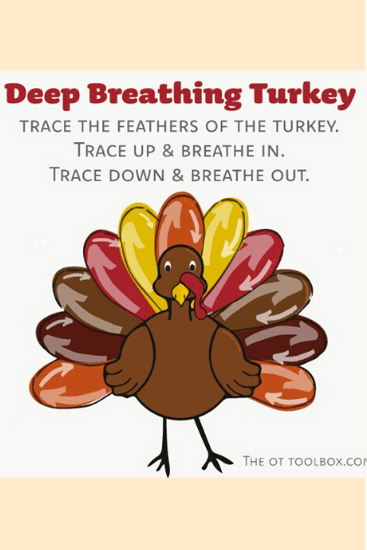
During the time of year when signs of a feast is everywhere (from a family get together to a feast in the classroom), it can be easy to become overwhelmed by tensions, boundaries of others, and even the over-abundance.
For our kiddos with sensory needs, we see this play out in emotions, behavioral meltdowns, and sensory regulation needs.
However, for ALL of us, sometimes having an open mind and mindful strategies can support a complex season.
Mindfulness for kids can be a creative way to address common concerns with attention, self-regulation, self-awareness, coping skills, and concentration.
Mindfulness activities can be a way for kids to be more present in the moment, and more aware of themselves in every situation, including in the home, in the classroom, and while performing everyday activities.
With the turkey exercise below, we use a few areas of mindful attention:
- Deep breathing
- Coloring (if using the coloring page)
Deep breathing exercises can improve a child’s attention, emotional regulation through mindful attention to Breath Control.
Breathing exercises are a coping tool to support relaxation by attentive breathing. When focused breathing occurs with breath control to inhale a deep, diaphragmatic breathing strategy, and then held for a moment to hold the breath at full capacity, there are many calming benefits, which can slow a racing mind. This relaxation breathing is a breath control mechanism.
Mindfulness Strategies for Big Holidays
There are many ways to incorporate mindfulness into holidays like Thanksgiving or Christmas. You can still honor the spirit of Thanksgiving or other big holidays even when overwhelm and a racing mind are at play.
Here are some of our favorite mindfulness tools for holidays:
- Fun Mindfulness activities for kids– creative mindfulness exercises that can help kids feel better, reduce stress, address anxiety, and have a greater awareness of their body and mind. Mindfulness activities for kids can be used as a self-regulation tool or a coping strategy.
- Go for a quick walk to add movement, heavy work through the body, and the opportunity to take a few deep breaths.
- Make a list of things you are grateful for. Use that gratitude to pray, give thanks, or use in gratitude meditation.
- Talk about gratitude with kids. This Bear Says Thanks activity is a great hands-on activity for this lesson.
- Take a walk in nature and practice gratitude while walking
- Talk about gratitude. You don’t need to save thankfulness for the Thanksgiving table. Talk about the things you are thankful for each day.
- Consider mindful eating during big meals or family meals.
- Winter Theme Mindfulness Activities– Use these tips for mindfulness in the classroom and creative mindfulness exercises with a winter theme.
- Mindfulness Videos on YouTube– Use these YouTube videos to help kids pay attention and responding to input from the world around us, including emotionally and cognitively.
- Make gratitude and mindfulness a habit.
- Adding a quick morning meditation can help with overall wellbeing.
- Hug your friends and family. Did you know there are benefits to giving and receiving hugs? Not only do they offer proprioceptive input through deep pressure, but they can be very calming.
Turkey Exercise for Mindfulness
This mindfulness activity is a fun one for kids this time of year. Like our pumpkin deep breathing exercise, we used a visual graphic of a turkey paired with directions to breathe deeply as a sensory coping strategy. Use the turkey deep breathing activity to teach kids mindfulness and awareness.
Use the printable along with these free Thankful Turkey Templates for hands-on play.
What better activity is there for Thanksgiving and the season of gratitude?
- Kids can use this Thanksgiving mindfulness activity to wind down after a busy day, cope with sensory overload, and be more aware of things they can express gratitude for.
- Use the printable turkey exercise as a breathing tool during the chaos of a family dinner.
- Use this Thanksgiving themed mindfulness tool to address sensory issues such as sensory overload. It’s a great way to add a mini-sensory break into busy days filled with family and festivities. Simply taking a few moments to add deep breathing exercises can help with feelings of overwhelming sensory overload and add the calming moment a child might need.
- It works for kids of all ages, too…take a few moments with your kiddos to step back, breathe deeply, and express gratitude or awareness.
It’s a great way to introduce mindfulness to children with a visual representation of the deep breathing strategy and awareness of the world around them.
Ok, so how does this work? Let’s try this mindfulness meditation task!
How to Use this Turkey Exercise for Mindfulness
Print off the turkey exercise by entering your email address into the form below. This resource is also available in our OT Toolbox Member’s Club, on the Thanksgiving Therapy Theme page.
- Use the visual graphic to follow the arrows as you take deep breaths in and out.
- Pair the deep breathing with thoughts of things that you are thankful for with each breath.
- For each feather on the turkey, you will concentrate on one thing, person, or aspect that you are thankful for. Maybe it’s a warm house. Maybe you are thankful for the sun shining outside. Maybe it’s a frantic house filled with family and friends. Maybe it’s a job that pays the bills.
Thinking about whatever it is that you are grateful for is a simple way to pair the benefits of slow deep breaths with intentional thoughts.
Use the Thanksgiving mindfulness with kids as a group or individually. You can set this up in several ways. Ask them fist to list out some things they are thankful for. Then, quietly say an item with each breath break.
Use the Turkey Deep Breathing Exercise in a Group
This exercise is a great addition to group gratitude activities.
As a mindfulness group activity, use the turkey graphic and explain that they will be pairing deep breathing with a focus on gratitude. Come up with a list of things the group is thankful for and as you work through he deep breathing exercise, the children in the group can focus on things that they are thankful for personally.
Or, you could invite the child to think in their head about some things they are thankful for and then with each breath in, they intentionally concentrate on that thing/person/idea.
Adding the deep breathing exercise with intentional thoughts makes this a Thanksgiving Mindfulness activity that can be so helpful for kids (and adults) of all ages!
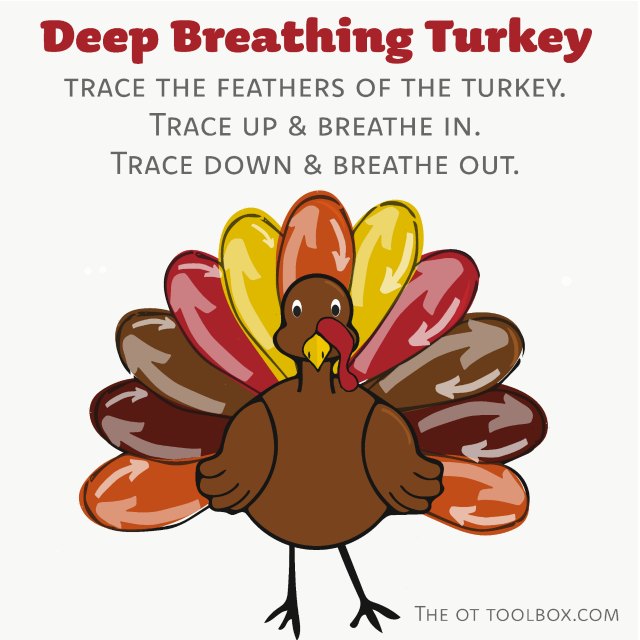
Thanksgiving Exercise for Deep Breathing
When focusing on gratitude and mindfulness during the Thanksgiving holiday, having an exercise with a turkey theme is a fun way to support self-regulation needs.
If you include this Thanksgiving exercise with gratitude and mindful breathing, it’s a great sensory tool, especially when worries or overthinking is happening. Gratitude and mindfulness can be powerful coping tools for anxiety by helping individuals shift their focus from negative thoughts and worries to more positive and present-moment experiences.
Pair this Thanksgiving exercise with gratitude by asking the user to think of things they are thankful for as they complete each breathing exercise.
This can help the user because mindful breathing and gratitude helps us to be present in the moment, promotes relaxation, and supports emotional regulation.
Free Thanksgiving Mindfulness Exercise
You can print off a version of this turkey exercise deep breathing tool. Enter your email address into the form below. The OT Toolbox Member’s Club members can access this resource inside our Member’s Club on the Thanksgiving Therapy Theme page.

Colleen Beck, OTR/L has been an occupational therapist since 2000, working in school-based, hand therapy, outpatient peds, EI, and SNF. Colleen created The OT Toolbox to inspire therapists, teachers, and parents with easy and fun tools to help children thrive. Read her story about going from an OT making $3/hour (after paying for kids’ childcare) to a full-time OT resource creator for millions of readers. Want to collaborate? Send an email to contact@theottoolbox.com.


